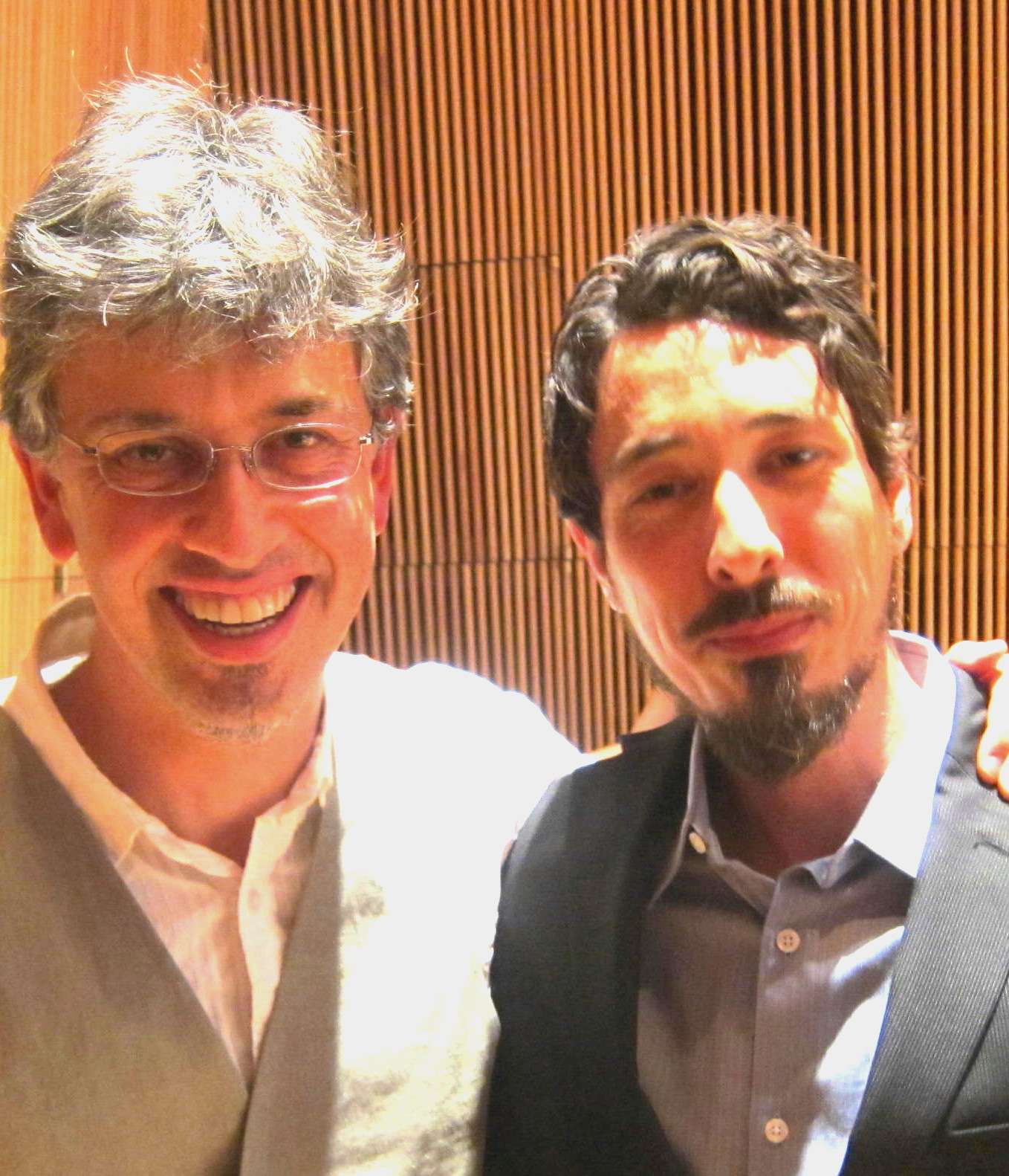|
Back
Perambulating Around The Cosmos New York
DiMenna Centre for Classical Music
03/02/2012 -
“The Machine Breathes”
Pierre Boulez: Dialogue de l’ombre double
Mark Menzies: Swongering Butterfly
Kimmo Hakola: Capriole
Luigi Nono: La lontananza nostalgica utopica futura
Ensemble Sospeso: Alicia Lee (Clarinet, Bass clarinet), Andrea Lee (Cello), Mark Menzies (Violin), Jason Ponce (Electronics)
Lisa Marks (Space Concept and Design: The Arts of Tension)

Andrea & Alicia Lee (© Coco T. Dawg)
Double fugues? Yes. Double canons? Sure. But double Doppelgangers?? Ah, that is a rarity which only a rare artist like Alicia Lee can achieve.
Which she certainly did at one of those all too rare concerts by Ensemble Sospeso which, if you haven’t heard of it before (I hadn’t), you must know about now. The ad hoc group, specializing in contemporary music, has been performing since 1995, but they have no permanent venue, and their artists are in such great demand, that they are not exactly a household (or even an elitist salon) name.
But in the world of contemporary music, they are in a class of their own. They have no “program” per se, but a beautiful, anciently printed document with a variety of essays by musicians and poets, as well as engravings by Albrecht Dürer and more modern artists in the Alt Deutsch style. Their venues include the Bohemian National Hall, and the lofty DiMenna Center for Classical Music, where a 25-foot-high series of stretched-out cloths around the room hid an octet of loudspeakers, surrounding the audience, themselves an orbit around the players.
And the musicians...? Well, back to Alicia Lee’s two Doppelgangers. One of the most brilliant clarinetists working today, both as soloist and ensemblist, Ms. Lee chose two of the works, both exhibiting her “shadows.”
One was the Pierre Boulez Dialogue de l’ombre double (Dialogue of the Double Shadow), based on a scene from a Paul Claudel drama where the shadows of two lovers are witnessed embracing and actually become one figure. This inspired Boulez to create a work for one pre-recorded clarinet (Ms. Lee), played in darkness on the tape over six speakers. Lights go on and the “live” clarinet (Ms.Lee) plays “against” the taped clarinet. Lights are on and off throughout the work, and the series of sounds–which are doubtless constructed from some arcane mathematical equations to which I am not privy–go on until the total darkness at the end.
In a way, it was exactly the same as Luigi Nono’s ...sofferte ohde serene..., performed on Monday, where a live piano plays against a pre-recording of the same work with variations. That one, with its nuances of waves and bells, was easily accessible. The Boulez was stunning just for Ms. Lee’s mastery of the incessant flutter-tongues, the harmonic sounds, the tremolos without tones, the mixture of aural magics produced by both Ms. Lee and her taped “partner”
The second “double-body” was genetic. Alicia Lee’s twin sister, cellist Andrea, is also a specialist in futuristic composition, (the whole family is made of musicians), but cellists and clarinetists are not exactly commonly paired together as soloists.
Finnish composer Kimmo Hakola had solved that with his Capriole for bass clarinet and cello, for which the sisters made an umbilical wonderment.
This was the only work with some “humor” as the two instruments imitated each other, went quarter-note and quarter-tone against each other, flatulated (the bass clarinet was probably invented to imitate flatus noises), played an offbeat slow movement (which sounded like a Chinese folk song) and came back for more sibling rivalry. Pure delight.

M. Menzies, J. Ponce (© Coco T. Dawg)
Mark Menzies was paired with violinist Alicia Lee in his own work, based on philosophical poetic meditation The sounds of violin and clarinet vied with incredibly violent tape sounds, modulated by Jason Ponce, and while I didn’t ever catch the structure, again the sounds were their own reward. Part was apparently a bird from Mr. Menzies native New Zealand, but, like the kiwi, it didn’t quite fly.
The second half was devoted to almost an hour of Luigi Nono, and I had made the mistake of finding a recording of La lontananza nostalgica utopica futura (Nostalgia for a Faraway Utopia) and listening to it. Violinist Menzies looked at me in horror when I mentioned it.
“No, no,” he said. (This was an admonition, not a mention of the composer). “You must watch the music.”
True enough, Mr. Menzies had placed about ten score-holders around the stage and audience. Throughout the long, long-long work, he played sections, would perambulate slowly, uncertainly, from one music-stand to another, almost brushing by the audience, and offered his aural sacrifices.
The work was written for Gidon Kremer–though Mr. Menzies is famed for playing it–so every violent, expressive violin technique was used. He would bow on the tailpiece, play hard against the fingerboard, play between bridge and tailpiece, and let out one explosion after another, with sounds ranging from the pppppp to explosive ffffffff.
I wasn’t quite convinced, though I understood the perambulations. (Nono’s motto for the work was “Travelers, there are no paths. You must walk.”
So the violinists was the walker, the electronics “walked” between eight speakers, and we, the audience, had to repose and hear the sounds from all corners. I daresay Luigi Nono wouldn’t have worried that the spectacle was more approachable than the music.
“You, the audience,” he might have said, “only have to walk with your own ears. I won’t give you any clues or any paths. Simply listen to the scenery as best you can.”
A challenging thought for a challenging and extraordinary evening.
****************************************************
Two more Ensemble Sospeso programs are scheduled for this year: On April 20, will be presented “The Empire Falls Off A Cliff” with music by Janácek, Prokofiev and Berio. On May 20 will be “Picking Up The Pieces”, highlighting the complete Kafka Fragments by György Kurtág.
Harry Rolnick
|